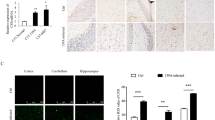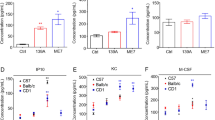Abstract
As an integral part of the innate immunity, the complement system has been reported to involve in the pathogenesis of prion diseases (PrD). However, the states of expression and activity of complement proteins in experimental models of scrapie infection are still not fully understood. Herein, the state of complement activation, the presence, and distribution as well as localization of C3 and membrane attack complex (MAC) in the brains of several scrapie-infected rodents were comparatively assessed through various methodologies. Our data illustrated a significant increase in the total complement activity (CH50, U/ml) in several scrapie-infected rodent brains at the terminal stage and a time-dependent upregulation of C1q in 263K-infected hamsters during the incubation period, intimating the sustained and progressive activation of the classical pathway during PrD progression. Confocal microscopy revealed robust activation of C3 and its localization to various central nervous system (CNS) cells with differential morphology in the brain tissues of both 263K-infected hamsters and 139A-infected C57BL/6 mice at disease end stages. Dynamic analyses of MAC in the brains of 263K-infected hamsters and 139A-infected C57BL/6 mice demonstrated remarkably time-dependent deposition during the incubation period, which may highlight a persistently activated terminal complement components. Moreover, immunofluorescent assays (IFAs) showed that MAC-specific signals appeared to overlap with morphologically abnormal neurons rather than proliferative astrocytes or activated microglia throughout the CNS of both 263K-infected hamsters and 139A-infected C57BL/6 mice. Overall, these results indicate that the activation of the complement system and the subsequent localization of the complement components to neurons may be a hallmark during prion infection, which ultimately contribute to the neurodegeneration in PrD.











Similar content being viewed by others
References
Prusiner SB (1982) Novel proteinaceous infectious particles cause scrapie. Science 216(4542):136–144
Collinge J, Palmer MS (1994) Prion diseases. In: Levy R (ed) Burns A. Dementia, Springer US, pp 835–853
Brown K, Mastrianni JA (2010) The prion diseases. J Geriatr Psychiatry Neurol 23(4):277–298
Wadsworth JDF, Collinge J (2010) Molecular pathology of human prion disease. Acta Neuropathol 121(1):69–77
Morley BJ, Walport MJ (2000) 2—the complement system. In: Morley BJ, Walport MJ (eds) The complement FactsBook. Academic, London, pp 7–22
Ricklin D, Hajishengallis G, Yang K, Lambris JD (2010) Complement: a key system for immune surveillance and homeostasis. Nat Immunol 11(9):785–797
Liszewski MK, Farries TC, Lublin DM, Rooney IA, Atkinson JP (1996) Control of the complement system. Adv Immunol 61:201–283
Walport MJ (2001) Complement first of two parts. N Engl J Med 344(14):1058–1066
Walport MJ (2001) Complement second of two parts. N Engl J Med 344:1140–1144
Janeway CA, Travers P, Walport M, Capra JD (2001) Immunobiology: the immune system in health and disease, vol 2. Livingstone, Churchill
Shin ML, Rus HG, Niculescu FI (1996) Membrane attack by complement: assembly and biology of terminal complement complexes. Biomembranes 4:123
Papadimitriou JC, Ramm LE, Drachenberg CB, Trump BF, Shin ML (1991) Quantitative analysis of adenine nucleotides during the prelytic phase of cell death mediated by C5b-9. J Immunol 147:212–217
Triantafilou K, Hughes TR, Triantafilou M, Morgan BP (2013) The complement membrane attack complex triggers intracellular Ca2+ fluxes leading to NLRP3 inflammasome activation. J Cell Sci 126(Pt 13):2903–2913
Huber-Lang M, Sarma JV, Zetoune FS, Rittirsch D, Neff TA, McGuire SR, Lambris JD, Warner RL, Flierl MA, Hoesel LM, Gebhard F, Younger JG, Drouin SM, Wetsel RA, Ward PA (2006) Generation of C5a in the absence of C3: a new complement activation pathway. Nat Med 12(6):682–687
Zhou J, Fonseca MI, Pisalyaput K, Tenner AJ (2008) Complement C3 and C4 expression in C1q sufficient and deficient mouse models of Alzheimer’s disease. J Neurochem 106(5):2080–2092
Ishii T, Haga S, Yagishita S, Tateishi J (1984) The presence of complements in amyloid plaques of Creutzfeldt-Jakob disease and Gerstmann-Straussler-Scheinker disease. Appl Pathol 2(6):370–379
Klein MA, Kaeser PS, Schwarz P, Weyd H, Xenarios I, Zinkernagel RM, Carroll MC, Verbeek JS, Botto M, Walport MJ, Molina H, Kalinke U, Acha-Orbea H, Aguzzi A (2001) Complement facilitates early prion pathogenesis. Nat Med 7(4):488–492
Michel B, Ferguson A, Johnson T, Bender H, Meyerett-Reid C, Wyckoff AC, Pulford B, Telling GC, Zabel MD (2013) Complement protein C3 exacerbates prion disease in a mouse model of chronic wasting disease. Int Immunol 25(12):697–702
Zabel MD, Heikenwalder M, Prinz M, Arrighi I, Schwarz P, Kranich J, von Teichman A, Haas KM, Zeller N, Tedder TF, Weis JH, Aguzzi A (2007) Stromal complement receptor CD21/35 facilitates lymphoid prion colonization and pathogenesis. J Immunol 179(9):6144–6152
Michel B, Ferguson A, Johnson T, Bender H, Meyerett-Reid C, Pulford B, von Teichman A, Seelig D, Weis JH, Telling GC, Aguzzi A, Zabel MD (2012) Genetic depletion of complement receptors CD21/35 prevents terminal prion disease in a mouse model of chronic wasting disease. J Immunol 189(9):4520–4527
Kovacs GG, Gasque P, Ströbel T, Lindeck-Pozza E, Strohschneider M, Ironside JW, Budka H, Guentchev M (2004) Complement activation in human prion disease. Neurobiol Dis 15(1):21–28
Meade-White KD, Barbian KD, Race B, Favara C, Gardner D, Taubner L, Porcella S, Race R (2009) Characteristics of 263 K scrapie agent in multiple hamster species. Emerg Infect Dis 15(2):207–215
Shi Q, Zhang B-Y, Gao C, Zhang J, Jiang H-Y, Chen C, Han J, Dong X-P (2012) Mouse-adapted scrapie strains 139A and ME7 overcome species barrier to induce experimental scrapie in hamsters and changed their pathogenic features. Virol J 9(1):63
Kim YS, Carp RI, Callahan SM, Wisniewski HM (1987) Incubation periods and survival times for mice injected stereotaxically with three scrapie strains in different brain regions. J Gen Virol 68:695–702
Stevens B, Allen NJ, Vazquez LE, Howell GR, Christopherson KS, Nouri N, Micheva KD, Mehalow AK, Huberman AD, Stafford B, Sher A, Litke AM, Lambris JD, Smith SJ, John SW, Barres BA (2007) The classical complement cascade mediates CNS synapse elimination. Cell 131(6):1164–1178
Webster S, Lue LF, Brachova L, Tenner AJ, McGeer PL, Terai K, Walker DG, Bradt B, Cooper NR, Rogers J (1997) Molecular and cellular characterization of the membrane attack complex, C5b-9, in Alzheimer’s disease. Neurobiol Aging 18(4):415–421
Yasuhara O, Aimi Y, McGeer EG, McGeer PL (1994) Expression of the complement membrane attack complex and its inhibitors in Pick disease brain. Brain Res 652(2):346–349
Ramaglia V, King RH, Nourallah M, Wolterman R, de Jonge R, Ramkema M, Vigar MA, van der Wetering S, Morgan BP, Troost D, Baas F (2007) The membrane attack complex of the complement system is essential for rapid Wallerian degeneration. J Neurosci Off J Soc Neurosci 27(29):7663–7672
Farkas I, Baranyi L, Ishikawa Y, Okada N, Bohata C, Budai D, Fukuda A, Imai M, Okada H (2002) CD59 blocks not only the insertion of C9 into MAC but inhibits ion channel formation by homologous C5b-8 as well as C5b-9. J Physiol 539(Pt 2):537–545
Rus HG, Niculescu FI, Shin ML (2001) Role of the C5b-9 complement complex in cell cycle and apoptosis. Immunol Rev 180:49–55
Fosbrink M, Niculescu F, Rus H (2005) The role of c5b-9 terminal complement complex in activation of the cell cycle and transcription. Immunol Res 31(1):37–46
Tegla CA, Cudrici C, Patel S, Trippe R, Rus V, Niculescu F, Rus H (2011) Membrane attack by complement: the assembly and biology of terminal complement complexes. Immunol Res 51(1):45–60
Soane L, Cho HJ, Niculescu F, Rus H, Shin ML (2001) C5b-9 terminal complement complex protects oligodendrocytes from death by regulating Bad through phosphatidylinositol 3-kinase/Akt pathway. J Immunol 167(4):2305–2311
Ren G, Huynh C, Bijian K, Cybulsky AV (2008) Role of apoptosis signal-regulating kinase 1 in complement-mediated glomerular epithelial cell injury. Mol Immunol 45(8):2236–2246
Huynh C, Ren G, Papillon J, Guillemette J, Takano T, Cybulsky AV (2009) The cytoprotective role of Ras in complement-mediated glomerular epithelial cell injury. Clin Immunol 131(2):343–353
Kissel JT, Mendell JR, Rammohan KW (1986) Microvascular deposition of complement membrane attack complex in dermatomyositis. N Engl J Med 314(6):329–334
Acknowledgments
This work was supported by Chinese National Natural Science Foundation Grants (81301429, 81401670), China Mega-Project for Infectious Disease (2011ZX10004-101, 2012ZX10004215), SKLID Development Grant (2012SKLID102, 2011SKLID211).
Author information
Authors and Affiliations
Corresponding author
Additional information
Yan Lv and Cao Chen contributed equally to this study.
Electronic supplementary material
Below is the link to the electronic supplementary material.
Supplemental Figure 1
Serially optical scanning of the individual graphs of C5b-9, NeuN, DAPI and merged ones in the brain slices (cortex region) per 1.0 μm by confocal microscopy. A. 263K-infected hamster (×100). B. normal hamster (×100). C. 139A-infected mouse (×100). D. normal mouse (×100). Arrow points out that the images are captured from the bottom to the top. (PDF 973 kb)
Rights and permissions
About this article
Cite this article
Lv, Y., Chen, C., Zhang, BY. et al. Remarkable Activation of the Complement System and Aberrant Neuronal Localization of the Membrane Attack Complex in the Brain Tissues of Scrapie-Infected Rodents. Mol Neurobiol 52, 1165–1179 (2015). https://doi.org/10.1007/s12035-014-8915-2
Received:
Accepted:
Published:
Issue Date:
DOI: https://doi.org/10.1007/s12035-014-8915-2




